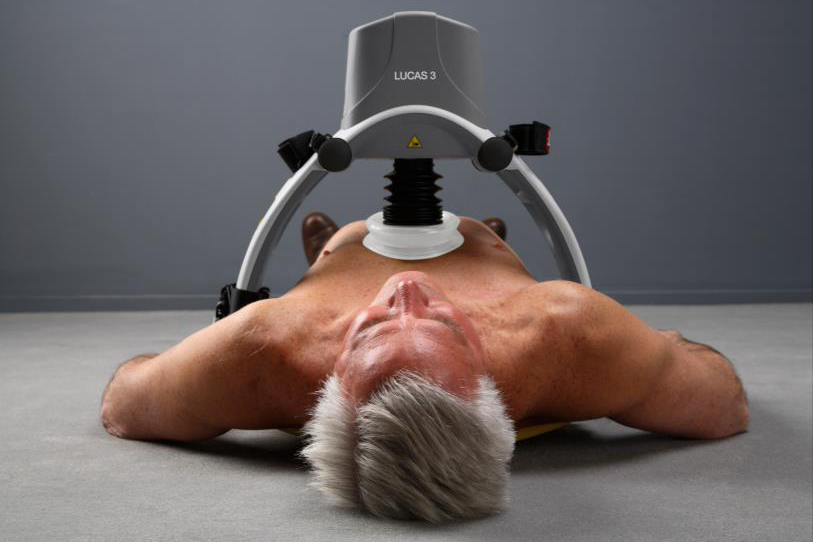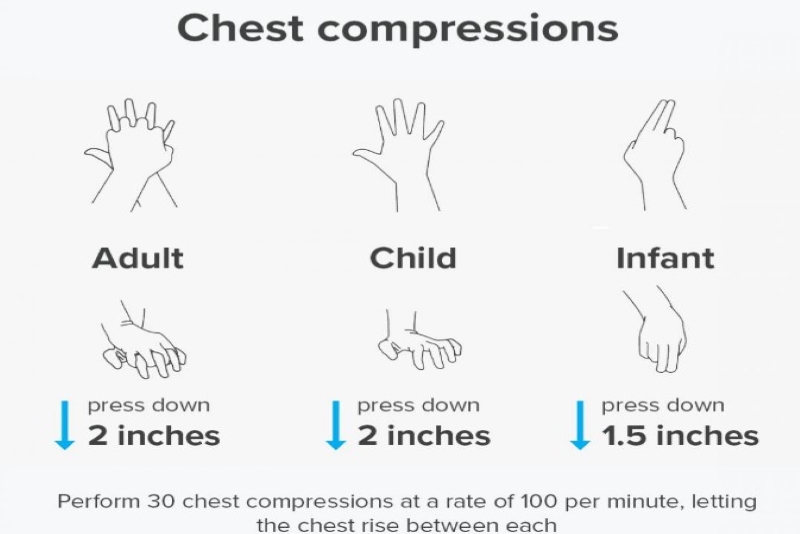
All You Need To Know About Automated CPR Machine: Cardiopulmonary Resuscitator / Chest Compressor
Cardiopulmonary resuscitation (CPR): before going into the details of what a chest compressor is, let’s try to understand the product and its application, which will help you decide when purchasing a CPR machine
WHAT IS CARDIOPULMONARY RESUSCITATION (CPR)?
CPR, commonly known as CPR, is a life-saving technique useful in many emergencies such as cardiac arrest or near-drowning, where a person’s breathing or heartbeat has stopped.
If you are afraid to practice CPR or are not sure how to perform it correctly, know that it is always better to try than to do nothing.
The difference between doing something and doing nothing could be someone’s life.
CPR can maintain the flow of oxygen-rich blood to the brain and other organs until emergency medical care can restore a typical heart rhythm.
This is important, because without oxygen one can suffer permanent brain damage or die in less than 8 minutes.
Only 2% of adults worldwide know how to perform CPR.
For every minute that passes without CPR and defibrillation, a patient’s chances of survival decrease by 7-10%.
The survival rate for cardiac arrest is less than 12%, but when CPR is administered, the survival rate rises to 24-40%, in some countries of the world even more.
Learning to perform CPR in a cardiac emergency is the fundamental skill to start the chain of survival.
WHAT TO DO BEFORE PERFORMING CARDIOPULMONARY RESUSCITATION (CPR)?
RCP CHECKLIST:
- Is the environment safe for the person?
- Is the person conscious or unconscious?
If the person appears unconscious, tap or shake the person’s shoulder and ask aloud: “Are you OK?”.
If the person is unresponsive and you are with another person who can help, ask a person to call 112 or the local emergency number and get the AED (Automated External Defibrillator), if available.
Remember that with the most recent legislation, AEDs are dotted around all public places, so… don’t lose your cool and watch carefully around you.
Ask the other person to start CPR.
If you are alone and have immediate access to a telephone, call 112 or the local emergency number before starting CPR.
If it is available, get the AED.
As soon as the AED is available, deliver a shock if indicated by the device, then start CPR.
The instructions on the device are clear, but the dispatcher will still be able to guide you remotely.
WHAT ARE THE STEPS TO PERFORM CARDIOPULMONARY RESUSCITATION?
Call 112 or ask someone else to do it.
Lay the person on their back and open the airway.
Check for breathing and pulse. If they are not there, start CPR.
Perform 30 chest compressions at a rate of 100 per minute.
Perform two rescue breaths.
Repeat until an ambulance or AED (Automated External Defibrillator) arrives.
REMEMBER THIS WHILE PERFORMING CARDIOPULMONARY RESUSCITATION (CPR):
A-B-C OF RCP
1) AIRWAYS
How to open the airway?
Carefully place the person on their back and kneel beside their chest.
Tilt the head slightly backwards by lifting the chin.
Open the mouth and check for an obstruction, such as food or vomit.
Remove the obstruction if it is loose.
If it is not loose, attempting to grasp it may push it further into the airway.
2) BREATHING
How to check breathing?
Bring the ear close to the person’s mouth and listen for no more than 10 seconds.
If no breathing is heard or only occasional gasps are heard, start cardiopulmonary resuscitation.
If a person is unconscious but still breathing, do not perform CPR.
How to check for a pulse?
Place the index and middle finger on the side of the neck, just below the jaw and next to the trachea.
Do not use your thumb.
If you do not feel a pulse or if you feel a weak and irregular pulse, start CPR.
The pulse can be checked by placing the index and middle finger on the inside of the wrist, at the base of the thumb.
3) COMPRESSIONS
How to perform compressions?
Adult – Place one hand on top of the other and squeeze them together.
With the heel of the hands and elbows straight, push hard and fast into the centre of the chest, slightly below the nipples.
Push at least 5 cm deep.
Compress the chest at a rate of at least 100 times per minute.
Allow the chest to rise completely between compressions.
Child – Place the heel of one hand in the centre of the chest at the level of the nipples.
You can also push with one hand on top of the other.
Push at least 5 cm deep.
Make sure not to press on the ribs, as they are fragile and prone to fracture.
Perform 30 chest compressions, at a rate of 100 per minute.
Allow the chest to rise completely between the pushes.
Infant – Place the index and middle finger on the sternum.
Make sure not to press on the end of the sternum.
Press about 1.5 inches deep.
Perform 30 compressions, at a rate of 100 per minute.
Allow the chest to rise completely between the pushes.
For infants, the mouth and nose must be sealed during rescue breathing.
Try to provide 12 to 20 rescue breaths per minute for an infant who is not breathing.
This is one rescue breath every 3-5 seconds.
WHEN TO USE CARDIOPULMONARY RESUSCITATION?
Use CPR when an adult is not breathing at all.
A person may need CPR if they stop breathing in any of the following circumstances:
- Cardiac arrest or heart attack
- Suffocation
- Traffic accident
- Near drowning
- Suffocation
- Poisoning
- Drug or alcohol overdose
- Electrocution from smoke inhalation
- Suspected sudden infant death syndrome
WHAT IS AN AUTOMATED CARDIOPULMONARY RESUSCITATION MACHINE?
The transition from manual CPR to compressions can be made with minimal disruption thanks to the lightness and ease of use of CPR machines.
They perform effective, personalised, hands-free CPR and never get tired.
They allow healthcare workers to focus on other life-saving procedures and provide better access to the patient.
They also allow rescuers to be positioned more safely and less likely to be injured.
An AED can be used in conjunction with the CPR machine.
The machine can continue chest compressions while the AED is set up.
Types of CPR machines
Sternal piston CPR machine
This type of CPR machine delivers compressions by operating a piston to compress the heart against the spine, in the same way as manual CPR.
It is manually set by the rescuer to deliver a fixed compression depth.
Load distribution band CPR machine
The load distribution band (LBD) is a circumferential chest compression device consisting of a pneumatically or electrically operated compression band and a backboard.
The LBD can be used by appropriately trained personnel in specific settings for the treatment of cardiac arrest.
Read Also
Emergency Live Even More…Live: Download The New Free App Of Your Newspaper For IOS And Android
Cardiopulmonary Resuscitation: The Compression Rate For CPR Of Adults, Children And Infants
Cardiac Arrest: Why Is Airway Management Important During CPR?
Holter Monitor: How Does It Work And When Is It Needed?
What Is Patient Pressure Management? An Overview
Head Up Tilt Test, How The Test That Investigates The Causes Of Vagal Syncope Works
Why Children Should Learn CPR: Cardiopulmonary Resuscitation At School Age
What Is The Difference Between Adult And Infant CPR
CPR And Neonatology: Cardiopulmonary Resuscitation In The Newborn
Defibrillator Maintenance: AED And Functional Verification
Defibrillator Maintenance: What To Do To Comply
Defibrillators: What Is The Right Position For AED Pads?
When To Use The Defibrillator? Let’s Discover The Shockable Rhythms
Who Can Use The Defibrillator? Some Information For Citizens
Diseases Of The Valves Of The Heart: Aortic Stenosis
What Is The Difference Between Pacemaker And Subcutaneous Defibrillator?
What Is An Implantable Defibrillator (ICD)?
What Is A Cardioverter? Implantable Defibrillator Overview
Paediatric Pacemaker: Functions And Peculiarities
Cardiac Arrest: Why Is Airway Management Important During CPR?
RSV (Respiratory Syncytial Virus) Surge Serves As Reminder For Proper Airway Management In Children
Supplemental Oxygen: Cylinders And Ventilation Supports In The USA
Heart Disease: What Is Cardiomyopathy?
Inflammations Of The Heart: Myocarditis, Infective Endocarditis And Pericarditis
Heart Murmurs: What It Is And When To Be Concerned
Broken Heart Syndrome Is On The Rise: We Know Takotsubo Cardiomyopathy
Cardiomyopathies: What They Are And What Are The Treatments
Alcoholic And Arrhythmogenic Right Ventricular Cardiomyopathy
Difference Between Spontaneous, Electrical And Pharmacological Cardioversion
What Is Takotsubo Cardiomyopathy (Broken Heart Syndrome)?
Dilated Cardiomyopathy: What It Is, What Causes It And How It Is Treated
Heart Pacemaker: How Does It Work?
Italy, ‘Good Samaritan Law’ Approved: ‘Non-Punishability’ For Anyone Using A Defibrillator AED
Oxygen Damaging For Heart Attack Patients, Study Says
European Resuscitation Council (ERC), The 2021 Guidelines: BLS – Basic Life Support
Paediatric Implantable Cardioverter Defibrillator (ICD): What Differences And Peculiarities?



